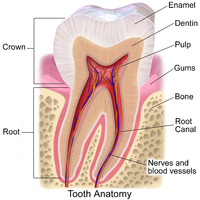
Photo from wikipedia
BACKGROUND Mucogingival deformities, and gingival recession in particular, are a group of conditions that affect a large number of patients. Since life expectancy is rising and people are retaining more… Click to show full abstract
BACKGROUND Mucogingival deformities, and gingival recession in particular, are a group of conditions that affect a large number of patients. Since life expectancy is rising and people are retaining more teeth both gingival recession and the related damages to the root surface are likely to become more frequent. It is therefore important to define anatomic/morphologic characteristics of mucogingival lesions and other predisposing conditions or treatments that are likely to be associated with occurrence of gingival recession. OBJECTIVES Mucogingival defects including gingival recession occur frequently in adults, have a tendency to increase with age, and occur in populations with both high and low standards of oral hygiene. The root surface exposure is frequently associated with impaired esthetics, dentinal hypersensitivity and carious and non-carious cervical lesions. The objectives of this review are as follows (1) to propose a clinically oriented classification of the main mucogingival conditions, recession in particular; (2) to define the impact of these conditions in the areas of esthetics, dentin hypersensitivity and root surface alterations at the cervical area; and (3) to discuss the impact of the clinical signs and symptoms associated with the development of gingival recessions on future periodontal health status. RESULTS An extensive literature search revealed the following findings: 1) periodontal health can be maintained in most patients with optimal home care; 2) thin periodontal biotypes are at greater risk for developing gingival recession; 3) inadequate oral hygiene, orthodontic treatment, and cervical restorations might increase the risk for the development of gingival recession; 4) in the absence of pathosis, monitoring specific sites seems to be the proper approach; 5) surgical intervention, either to change the biotype and/or to cover roots, might be indicated when the risk for the development or progression of pathosis and associated root damages is increased and to satisfy the esthetic requirements of the patients. CONCLUSIONS The clinical impact and the prevalence of conditions like root surface lesions, hypersensitivity, and patient esthetic concern associated with gingival recessions indicate the need to modify the 1999 classification. The new classification includes additional information, such as recession severity, dimension of the gingiva (gingival biotype), presence/absence of caries and non-carious cervical lesions, esthetic concern of the patient, and presence/absence of dentin hypersensitivity.
Journal Title: Journal of Periodontology
Year Published: 2018
Link to full text (if available)
Share on Social Media: Sign Up to like & get
recommendations!